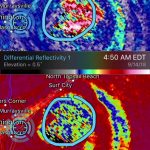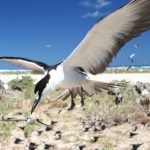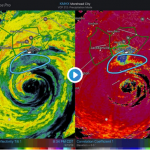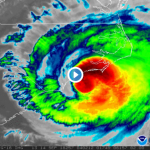How flocks of birds got trapped inside the eye of Hurricane Florence
In 1969, researchers spotted a black and white sooty tern in Michigan. This hardy seabird, however, had little business visiting the Midwest. The saltwater species usually spends its life in the tropics, more than 1,000 miles away.
Hurricane Camille — one of the most powerful storms in U.S. history — had trapped and carried the foreign creature to this distant land. Now similarly, tropical storm Florence, which made landfall Friday morning in North Carolina as a hurricane, has also ensnared birds deep inside the cyclone.
Using radar, several meteorologists have spotted the birds flying inside Florence’s eye. But why are they there?
Simply put, the eye of the storm, just outside the violent winds of the hurricane’s eyewall, is the best place to be.
“Sometimes these flocks are huge,” Ryan Huang, who researches the effects of storms on bird populations at Duke University, said in an interview. “It appears as if they’re clouds.”
Hurricane and bird researchers alike aren’t actually seeing individual birds on radar. Rather, they’re observing masses of objects that clearly aren’t little spherical raindrops.
They’re something else, something much wider than they are tall, “like winged objects,” Falko Judt, a research meteorologist at the National Center for Atmospheric Research, said via email.
“One way to make sense of this signal is assuming that what the radar sees is birds,” said Judt.
It almost certainly is.
“People say that it’s ridiculous that you’d be able to see birds on radar,” Kenn Kaufman, a bird expert and naturalist, said in an interview. “But it’s standard. You can see insects on radar.”
Traveling to the storm’s center
It’s little surprise that hurricanes trap birds as the storms churn over the ocean.
“There are a good numbers of birds out at sea all the time,” said Kaufman. “There are true seabirds that live out there.”
In addition, land birds also commonly migrate over the ocean. And come mid-September — the peak of the Atlantic hurricane season — the fall migration is in swing, noted Kaufman.
“They can’t fight it”
“By the second week of September, on a lot of days and nights there will be hundreds of thousands of small birds migrating over the open waters of the Atlantic,” he said.
When a storm brews nearby, spinning counterclockwise in spiraling bands, flocks of birds can fly in.
The wind is rushing toward the center, and grows increasingly stronger. It can be over 50 mph some 100 miles out from the core, like Florence — or raging 150 mph or greater in the core.
“They can’t fight it,” said Kaufman. “They have to fly downwind.”
Eventually, “they wind up in the eye and stay with it,” said Kaufman. “That’s obviously going to be preferable for them.”
A hellish ride
The eye of the storm might be a relatively tranquil retreat to ride out the screaming winds, but it’s still a harsh, if not deadly, experience for birds.
The animals are steering through the most extreme winds on the planet as they barrel through the storm, flying involuntarily downwind.
“Once they’re in the eye, they’re exhausted,” said Huang.
And to begin with, there’s a good chance the birds are running low on fuel
“Migrating is already a taxing process,” noted Huang.
Once the storm makes landfall, the land birds will likely swoop down out of the storm and take refuge, said Kaufman. Seabirds, like sooty terns, may still ride it out.
“Assuming you survive,” added Huang.
In the aftermath of hurricanes, Huang has found “wrecked birds washing up on seashores” and measured decreases in colony populations.
It’s a rough journey, any way you cut it.
“It’s got to be a little unnerving,” said Kaufman.
IMAGES:
A seabird thrown into unfriendly climes.IMAGE: BOB AL-GREENE/MASHABLE
A sooty tern rookery in the tropics. IMAGE: U.S. FISH AND WILDLIFE SERVICE
NOAA Satellites
RadarScope
Birds in the eye. Low correlation coefficient = non-met/biological scatterers. High Zdr somewhat a reflection of their wingspan. #Florence #Ncwx
For more on this story and video go to: https://mashable.com/article/hurricane-florence-birds-trapped-eye-storm/?utm_source=feedburner&utm_medium=feed&utm_campaign=Feed%3A+Mashable+%28Mashable%29









